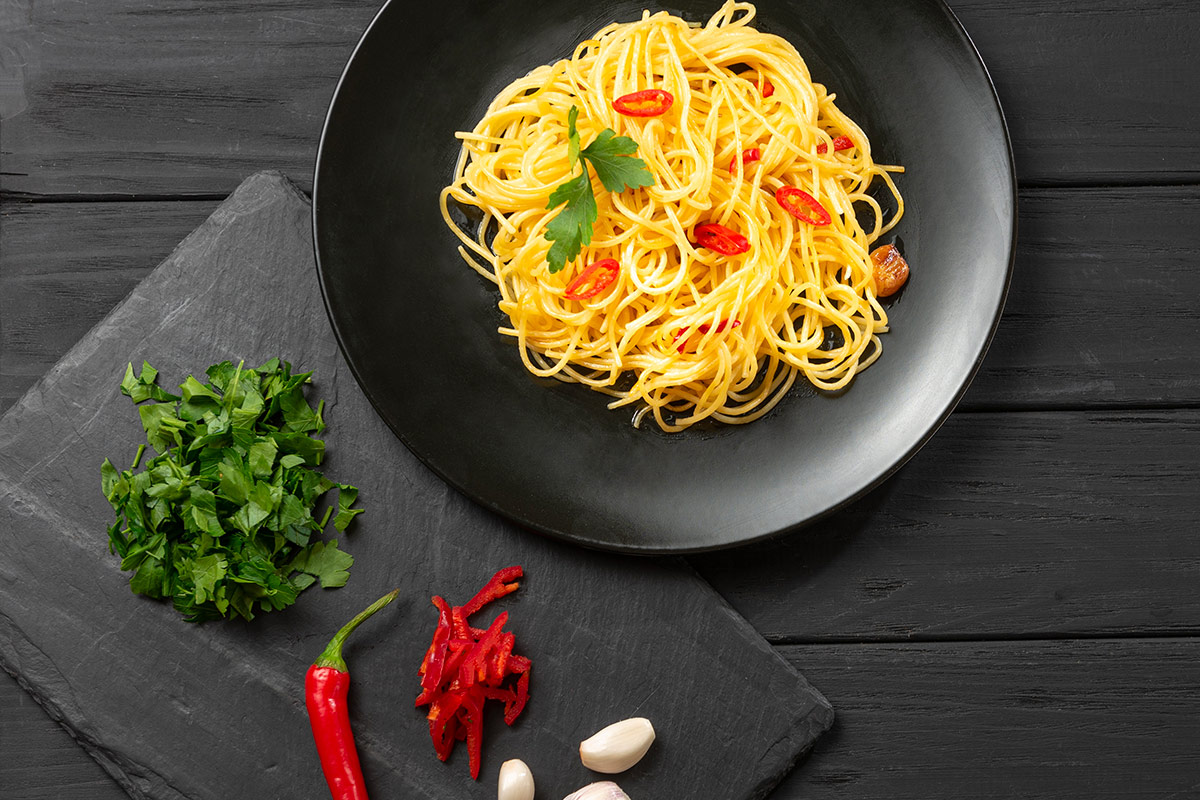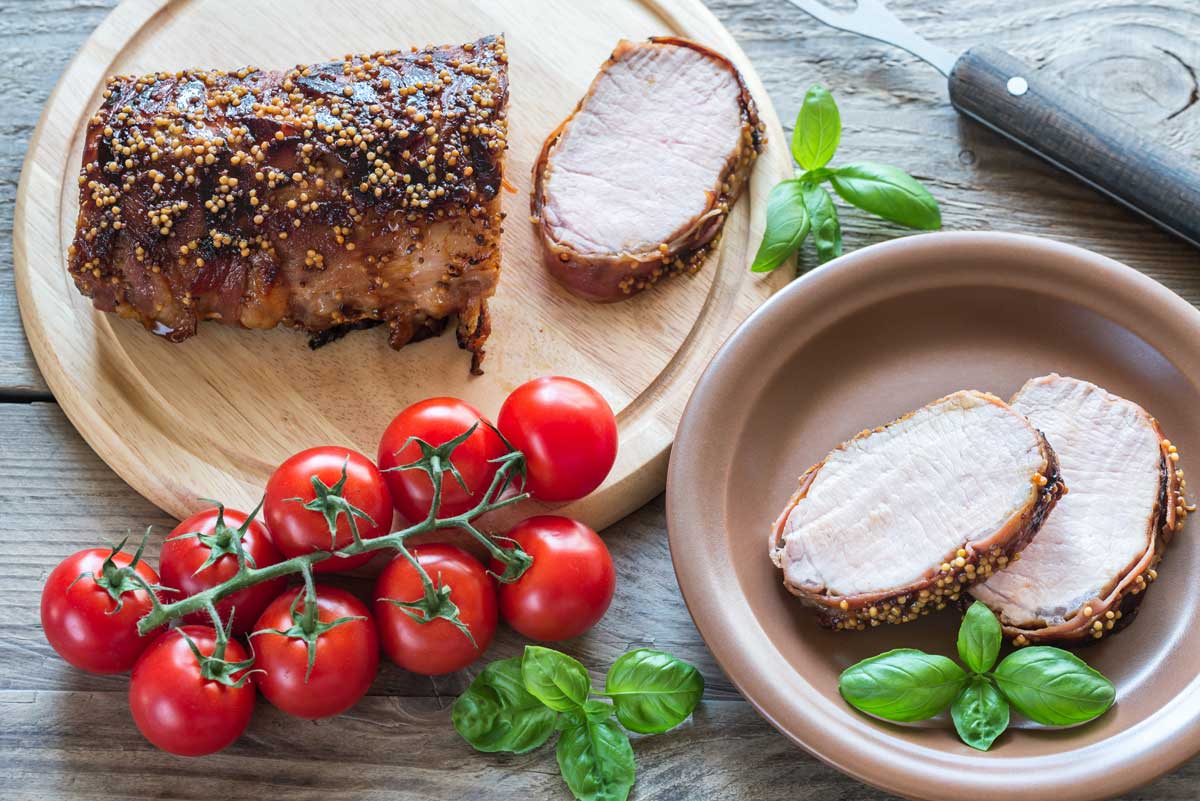Pasta with Garlic and Olive Oil Recipe, Protecting Brain Health Through Diet: More Benefits of the Olive Oil Lifestyle
More and more research is linking certain diets to better brain health and the possibility of warding off various types of dementia, including Alzheimer’s disease. It’s encouraging to read about variations on the Mediterranean diet, all of which deliver the benefits of olive oil. The study I’m sharing owes a huge debt to its participants who were willing to not only keep food diaries, but also allow scientists to examine their brains after they passed, thereby enlightening the rest of us. One clear message I like to communicate is that “good for you” foods also taste great—there doesn’t need to be a trade-off, as the following pasta recipe proves.
Pasta With Garlic and Olive Oil
 Pasta With Garlic and Olive Oil
Pasta With Garlic and Olive OilThis recipe hails from one of my favorite regions in one of my favorite countries—Lazio, Italy. Fresh-Pressed Olive Oil Club members recently got to savor a bold Canino olive oil from a wonderful producer, an agricultural cooperative of small local farmers who carry on their respective family traditions and passion for growing olives. I’m happy to say that this classic pasta dish is divine with any of the Club’s extra virgin olive oils! You probably have the ingredients in your kitchen already, so you can be enjoying it tonight. For an even healthier meal, choose whole wheat pasta or an alternative made with legumes, such as black beans or yellow pea protein.
Ingredients
- 1 tablespoon coarse salt
- 1 pound pasta, any variety, fresh or dried
- 1/3 cup extra virgin olive oil, plus more for drizzling
- 4 cloves garlic, minced
- 1 fresh pepperoncini or red chile pepper, thinly sliced, or crushed red pepper flakes to taste
- 1/4 cup chopped flat-leaf parsley
Directions
Step 1
Bring a large pot of cold water to a boil over high heat and add the salt. Add the pasta and cook until al dente, about 7 or 8 minutes.
Step 2
While the pasta is cooking, heat a large skillet and, when very warm, add the olive oil, garlic, and pepper (if using crushed flakes, add them later, as noted below). Cook over medium heat until the garlic softens and starts to turn color, about 5 minutes.
Step 3
Use tongs to transfer the pasta to the skillet along with a 1/4 cup of its cooking water. Toss well to coat the pasta in the oil and continue cooking for another 2 minutes until the pasta water is just about fully absorbed (if using pepper flakes, add them now). Sprinkle with the parsley, drizzle with more olive oil, and serve.
Yields 4 servings

Protecting Brain Health Through Diet
More Benefits of the Olive Oil Lifestyle
The Study: “Association of Mediterranean-DASH Intervention for Neurodegenerative Delay and Mediterranean Diets With Alzheimer Disease Pathology,” Neurology, March 8, 2023.
The Findings: People who eat diets rich in green leafy vegetables as well as other vegetables, fruits, whole grains, olive oil, beans, nuts, and fish may have fewer amyloid plaques and tau tangles in their brain—signs of Alzheimer’s disease—than people who do not consume such diets.
The Report: According to an American Academy of Neurology report on the study, researchers looked at how closely people followed the Mediterranean diet and a variation called the MIND (Mediterranean-DASH Intervention for Neurodegenerative Delay) diet. Although similar, the Mediterranean diet recommends vegetables, fruit, and three or more servings of fish per week, while the MIND diet prioritizes green leafy vegetables like spinach, kale, and collard greens, along with other vegetables and berries over other fruit, and recommends one or more servings of fish per week. Both the MIND and Mediterranean diets recommend small amounts of wine.
“These results are exciting—improvement in people’s diets in just one area, such as eating more than six servings of green leafy vegetables per week, or not eating fried foods, was associated with fewer amyloid plaques in the brain similar to being about four years younger,” says study author Puja Agarwal, PhD, of RUSH University in Chicago.
The study shows an association between regularly consuming these diets and fewer Alzheimer’s disease plaques and tangles, although it doesn’t establish a cause-and-effect relationship. “While our research doesn’t prove that a healthy diet resulted in fewer brain deposits of amyloid plaques, also known as an indicator of Alzheimer’s disease, we know there is a relationship, and following the MIND and Mediterranean diets may be one way that people can improve their brain health and protect cognition as they age,” explains Dr. Agarwal.
The study involved 581 people with an average age of 84 at the time of their diet assessment who agreed to donate their brains at death to advance dementia research. Participants completed annual questionnaires asking how much they ate of food items in various categories. The participants died an average of seven years after the start of the study. Right before death, 39 percent had been diagnosed with dementia. When examined after death, 66 percent met the criteria for Alzheimer’s disease.
At autopsy, researchers examined participants’ brains to determine the amounts of amyloid plaques and tau tangles (both are found in the brains of people with Alzheimer’s disease but may also be found in the brains of older people with normal cognition). They then looked back at the food questionnaires and ranked the quality of diet for each person.
For the Mediterranean diet, there were 11 food categories. Participants were given a score of zero to 55, with higher scores if they adhered to the diet in these categories: whole grain cereals, fruits, vegetables, legumes, olive oil, fish, and potatoes. They were given lower scores if they ate red meat, poultry, and full-fat dairy products.
For the MIND diet, there were 15 categories. Participants were scored one point each for eating from 10 brain-healthy food groups: green leafy vegetables, other vegetables, nuts, berries, beans, whole grains, fish, poultry, olive oil, and wine. They lost a point if they ate greater than recommended amounts of foods in five unhealthy groups: red meats, butter and margarine, cheese, pastries and sweets, and fried and fast food.
Researchers then divided participants into three groups for each diet and compared those in the highest groups to those in the lowest groups. For the Mediterranean diet, people in the highest group had an average score of 35, while those in the lowest group had an average score of 26. For the MIND diet, the highest group had an average score of nine while the lowest group had an average score of six.
After adjusting for age at death, sex, education, total calorie intake, and whether people had a gene linked to a greater risk of Alzheimer’s disease, researchers found people who scored highest for adhering to the Mediterranean diet had average plaque and tangle amounts in their brains similar to being 18 years younger than people who scored lowest. Researchers also found people who scored highest for adhering to the MIND diet had average plaque and tangle amounts similar to being 12 years younger than those who scored lowest.
When looking at single diet components, the researchers found that people who ate the highest amounts of green leafy vegetables—seven or more servings per week—had plaque amounts in their brains corresponding to being almost 19 years younger than people who ate the fewest (one or fewer servings per week). “Our finding that eating more green leafy vegetables is in itself associated with fewer signs of Alzheimer’s disease in the brain is intriguing enough for people to consider adding more of these vegetables to their diet,” says Agarwal. “Future studies are needed to establish our findings further.”
Note: A limitation of the study was that participants were mostly white, non-Hispanic, and older, so the results cannot be generalized to other populations.
Get More Recipes In Your Inbox!






